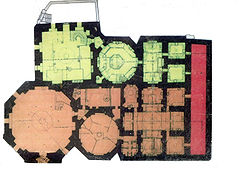
Bey Hamam
Encyclopedia


Hammam
A Turkish bath is the Turkish variant of a steam bath, sauna or Russian Bath, distinguished by a focus on water, as distinct from ambient steam....
located along Egnatia Street in Thessaloniki
Thessaloniki
Thessaloniki , historically also known as Thessalonica, Salonika or Salonica, is the second-largest city in Greece and the capital of the region of Central Macedonia as well as the capital of the Decentralized Administration of Macedonia and Thrace...
, east of Panagia Chalkeon. Built in 1444 by sultan Murad II
Murad II
Murad II Kodja was the Sultan of the Ottoman Empire from 1421 to 1451 ....
, it was the first Ottoman
Ottoman Empire
The Ottoman EmpireIt was usually referred to as the "Ottoman Empire", the "Turkish Empire", the "Ottoman Caliphate" or more commonly "Turkey" by its contemporaries...
bath in Thessaloniki and the most important one still standing throughout Greece
Greece
Greece , officially the Hellenic Republic , and historically Hellas or the Republic of Greece in English, is a country in southeastern Europe....
. For this reason, it is a part of those few important vestiges of Ottoman culture
Culture of the Ottoman Empire
The culture of the Ottoman Empire evolved over several centuries as the ruling administration of the Turks absorbed, adapted and modified the cultures of conquered lands and their peoples...
remaining in Thessaloniki and Greece in general.
It is a double bath, with two separate parts for men and women. The male quarters are the most spacious and luxurious, but each one follows the same tripartite plan - a succession of three parts, the cold, tepid, and hot rooms. A large rectangular cistern
Cistern
A cistern is a waterproof receptacle for holding liquids, usually water. Cisterns are often built to catch and store rainwater. Cisterns are distinguished from wells by their waterproof linings...
flanks the baths to the east and guarantees their water supply.
The baths for the men include a large octagonal cold room, with a gallery resting on columns, arcades surrounding their windows, and a painted cupola. It is followed, in south-east, by the tepid room, also octagonal, equipped with a cupola with occuli and with a rich series of painted depictions of plants. Further to the east lies the complex of hot rooms, ordered around a large cruciform room, wherein the massage table might always be found, standing, now as ever, in its centre. Eight small hot and tepid rooms open on this space and are equipped with basins and marble benches.
The baths remained in usage, under the name "Baths of Paradise", up until 1968, where they were leased to the Greek archaeological service for four years. After the earthquake of 1978, which shook Thessaloniki especially hard, the baths were restored, and are used to this day for cultural events and short-lived exhibitions. Meanwhile, the eastern annex became the principal shop of the Foundation of Archaeological Receipts of the Hellenic Republic Ministry of Culture.

